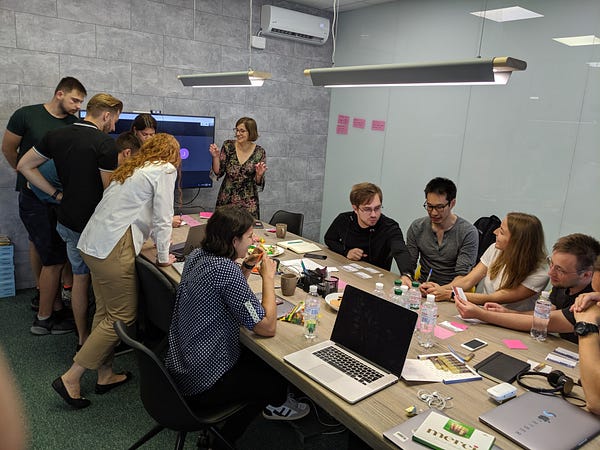So let’s get to it: How did we build our first own near-shoring team (5+ engineers) in less than 3 months, and had 20+ engineers after 5 months?
First of all we decided to work with a local partner. Why?
- We wanted to have our team ready to code in less than 3 months;
- we did not have resources in-house to take care of the near-shoring hiring activities, and, most importantly,
- we did not have the expertise to hire ourselves in a competitive near-shoring market (we did not speak the language and knew nothing about things like taxes or legal requirements in those countries).
Finding a strong local partner
This is how we found the best partner for us:
- We defined our preferred tech stack(s),
- generated a shortlist of partners, talked to them as well as some reference clients of them (2 weeks),
- visited the TOP 6 companies on-site (1 week),
- created a decision matrix (1 week),
- signed the contract and hired our team leads first (2 months),
- hired the rest of the tech teams together with our new leads.
Initially, we had video calls with a dozen providers in different countries such as Spain, Portugal, Serbia, and Ukraine. We selected different kind of providers (e.g. a smaller startup but also bigger companies with > 3.000 employees, different countries) to get different perspectives. After the initial calls we evaluated all companies with some criteria such as pricing, how long they are in that business, contract stuff, tech stack, but also soft factors like how good we got along with them.
At this stage we already had a clear picture of tech stacks we wanted to build our infrastructure on, which helps for the selection. For instance in Spain it is not so easy to find PHP developers, in Poland Ruby is king, while in Ukraine all major modern (web) tech stacks have a decent pool of talents. The larger the talent pool for a certain technology, the faster you can expect to hire in your selected region, but also the more competitive the hiring process will be.
Then we shortlisted our TOP 6 partners and visited their main offices to get a better feeling of their working environments. As we wanted our future team to be fully integrated into our company and culture, we needed to ensure they can expect a great work environment similar to ours in Germany and Switzerland.
After the on-site visits we created a decision matrix to determine the “winner”:

This matrix helped us to not get influenced too much by our gut feelings for such an important decision.
In the end we as a young and small startup entity partnered with Ciklum, to balance us with an established, experienced, and very professional IT partner, with whom we could easily scale our teams further in the future. We chose Kyiv in Ukraine as location with a daily direct 2-hour flight connection from our headquarter in Munich and a large base of IT professionals and tech graduates.
We chose a so-called “extended development team” partnership:
- The partner provided recruiting managers for us who know the local market well and fill positions on average within 4–8 weeks (depending on the talent competition in the near-shoring area, but in any case much faster than e.g. in Germany).
- Administrative overhead was done by the partner as well, e.g. taxes, employee contracts, office space and facility management, insurance, etc.
- Though our engineers were officially employed by the partner company, they still felt as if they were hired by us. We were fully involved in the recruiting interviews, we owned the onboarding process, we negotiated salaries, we conducted performance reviews, we could use all our internal tech tools (e.g. AWS), our engineers wore our company t-shirts, … you get it 🙂
- We could foster full company integration through close communication and regular f2f-meetings with our team (for example our PMs could work on-site regularly or we had several team events per year).
Our résumé

At the time of taking such important and complex decisions you cannot be 100% sure it was the right one. After 1.5 years though we could say we were very happy with our choice!
We’ve built a high-performing 20+ tech team within 5 months (depending on your needs it is also possible to hire much more in less time), we’ve had great cultural and social experiences in Kyiv, a beautiful and constantly developing city, and we were looking forward to expanding our team further.

However, fluctuation in Ukraine is high and salaries are constantly increasing due to a strong extrinsic motivation of the IT workforce and a highly competitive IT market.
To cope with that and to keep our retention rate high, we constantly invested time and effort to integrate the team fully into our company culture and provided them with a work environment our engineers could not find easily somewhere else.

The following turned out to be some important success ingredients for setting up our dedicated near-shoring tech teams:
- we took the time upfront to choose the right strategy and partner
- we had a CTO / Technical Architect in our core organisation to ensure excellent delivery quality, standards, and guidance of our teams
- we hired Senior engineering leads first even if that slightly delayed the hiring of the rest of the team
- we never made compromises in hiring: even if we wanted to hire fast, we rejected candidates that did not fully convince us
- we constantly invested time and effort to integrate the team fully into our company and provided the best work environment possible (for example through team events, an open feedback culture, free lunch)
- as we worked on MVPs, our engineers typically started writing the first line of code, had no legacy code to deal with, and could constantly work with the latest frameworks and libraries -> engineers obviously love that 🙂
What were your experiences and learnings building a tech team for your startup? Are you currently evaluating how to set up a new tech team for your company? Let me know in the comments!


